Matador Network's Blog, page 1134
March 26, 2019
Barbie releasing new travel dolls

Barbie is setting off to travel the world, this time for careers in the travel industry and sciences. A new travel-themed line of dolls, accessories, and media is slated for release. It will feature Barbie exploring the world and performing a variety of professions across the sciences. Barbie is partnering with National Geographic to create the line, which will feature career dolls and playsets that emphasize occupations generally underrepresented by women. The ultimate goal is to show children who might be interested in science, conservation, and travel that Barbie can be a role model for them too.

Photo: Mattel
Lisa McKnight, Senior Vice President and General Manager of Barbie, said in a statement, “Barbie allows girls to try on new roles through storytelling by showing them they can be anything. Through our partnership with National Geographic, girls can now imagine themselves as an Astrophysicist, Polar Marine Biologist, and more.” In addition to these, her new careers will include Wildlife Conservationist, Entomologist, and Photojournalist.

Photo: Mattel
The company is also releasing a new Barbie Dream Plane and Helicopter to get Barbie where she needs to go in style. Dolls and career playsets will cost between $14.99 and $29.99, and the new dolls and accessories are slated to go on sale in fall 2019. 
H/T: Travel & Leisure

More like this: This hotel in Mexico just launched a Barbie glamping room, Instagram influencers
The post Barbie is releasing a new set of travel-themed dolls appeared first on Matador Network.

The best restaurants in Denver

Just like the city itself, Denver’s restaurant landscape is quickly growing and improving. You can still find a cowboy-style meal that’s heavy on the beef (and plenty of Rocky Mountain oysters if you know where to look), but a young and diverse crop of chefs is keeping the options from getting stale.
“With the population boom came more restaurants, which pushed every chef and concept to change, innovate, and create with passion to be the best and win over customers,” chef Joseph Lewis of Rhein Haus and Wally’s Wisconsin Tavern said. “Any time of day, or day of the week, there is always a spot for a great meal.”
Increasingly, those meals are listed on constantly changing menus that rotate with what’s seasonally available.
“I feel that the growing community has blossomed with the advancement of our local growing scene, urban farms, and farmers markets,” executive chef Nick Kayser of Vesta said. “We have always been a top producer of beef and lamb, and with the roundness of the farming community, I feel ingredient-driven cuisine, focusing on our hyper-local ingredients is really starting to shape the dining scene here in Denver.”
To get a better sense of how to see Denver through the eyes of a chef, we got in touch with nine of the city’s best. Our experts include Lewis, Kayser, executive chef and partner Chris Royster of Flagstaff House Restaurant, executive chef Adam Vero of Hearth & Dram, executive chef and owner Mary Nguyen of Olive & Finch, executive chef Thach Tran of Ace Eat Serve, executive chef Duncan Homes of Beckon | Call, executive chef and partner Ryan Talor of Hickory & Ash and Masa, and chef Ivan Ceballos of Que Bueno Suerte!
This is how to eat all that Denver has to offer just like the city’s top chefs do.
The types of food that Denver does best

Photo: Hacienda Colorado/Facebook
“Denver excels at authentic, real Mexican food,” Nguyen said. “I’m thinking old school, like the Blue Bonnet, Hacienda Colorado, and Benny’s. I travel to NYC and can’t get real Mexican food there — they just don’t make green chile the way we do, don’t smother literally everything with cheese and Pueblo chilies, and you can’t grab tamales from street-side carts and vendors everywhere in the city.”
Nguyen isn’t alone in her thinking. “Denver is a hot spot for all styles of food, but our Latin food scene is where it’s at,” Lewis said. “From small mom-and-pop spots all the way to D’Corazon, from traditional to innovated takes on the classics, the flavor and experience are always great.”

Photo: Marco’s Coal Fired/Facebook
“Denver’s known for our ranching heritage, so it’s no surprise that we excel at butchery, sausage making, and charcuterie,” Vero said. “Also, a bit of an outlier, but we have the most amazing wood-fired pizza in Denver. Something about the altitude and dry climate combines to make incredible pizzas.”
If you’d asked the same question a decade ago, things would’ve been different. Things are much more seasonal these days. “Because of our city’s altitude and terrain, it’s a challenge to cook and eat locally year-round, but it’s so important when it comes to quality,” Royster said. “And we have lots of very talented chefs who take those efforts seriously and incorporate menu changes and creation of dishes based around what’s available locally, and not the other way around. That hasn’t always been the case, but I’m glad to see us moving in that direction.”
Where to eat when you only have an hour or two

Photo: The Denver Central Market/Facebook
“Places like Denver Central Market or Avanti Food and Beverage offer multiple options to choose from and they have a full bar to grab a cocktail, beer, or glass of wine while you’re there,” Royster said. “If it’s just a sandwich I really want, I like Rye Society. Their sandwiches bring me back the delis in NYC that I miss and love.”
Being short on time is an everyday struggle just as much for chefs as for everyone else. “I like the food halls and markets,” Tran said. “Denver Market and Broadway Market are my top two. I can grab coffee, snacks, lunch or dinner, a cocktail, and then chat it up with some industry friends.”
Ceballos listed Uno Mas Taqueria and Chook Charcoal Chicken for quick-bite options, and if a fast lunch is what you’re looking for, Lewis suggested Freshcraft for the meatloaf sandwich. Pizza is a classic go-to in a rush, and Taylor put Marco’s Coal Fired Pizza and White Pie at the top of the options to try. Then again, it’s hard to beat a solid sandwich you can walk with.
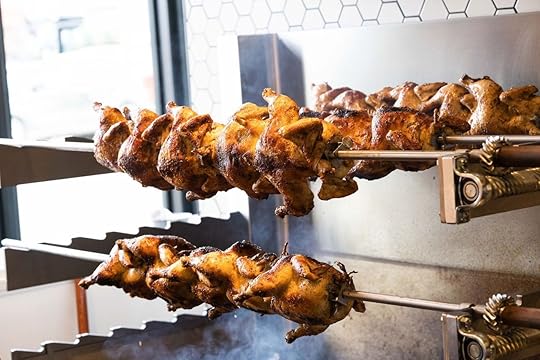
Photo: Chook Chicken/Facebook
“Lou’s Italian Specialties in RiNo is totally where it’s at in Denver,” Kayser said. “East Coast sandwiches and antipasta salads that complement perfectly is the best lunch you can grab with an available hour in the day.”
Vero agreed with the Lou’s Italian selection as well (especially the one with roast beef, giardiniera, provolone and au jus), along with the Chicago-style hotdogs from Mile High Vienna Stand, the banh mi from New Saigon, and the bagel from Rosenberg’s (“exactly the bagel I’m looking for the morning after a long night out,” Vero said).
Where chefs eat on their day off

Photo: Bar Dough/Facebook
For a day full of eating and drinking, Taylor suggested staples like the Spanish restaurant Ultreia, diner food at Sam’s No. 3, American food at Avelina, sushi from Sushi Sasa, and Latin-inspired food from Lena.
“My favorite is Pete’s Cafe off 88th and Washington,” Lewis said. “They have a rustic, old-timey diner feel, but the service is always great and the food delicious, especially the green chili.”
Among the many options, Nguyen’s favorites are Sushi Den, Marco’s Coal Fired Pizza, and the Plimoth. “All three just know exactly how to make great food and serve it with warmth and style,” she said.
“I’m at Bar Dough quite a bit on my days off,” Vesta said. “I love seeing what Chef Carrie Baird is doing with her rotating menu items, like her fancy toasts and pasta specials. I love the bar scene and their wine list rocks.”
There’s never a bad time to visit, but spring and fall win out for foodies.
Denver’s 300 days of sunshine and mix of both summer and winter outdoor activities make it a destination year-round. For food lovers, though, it’s hard to beat the fall. “The weather is cooling down a bit and the change between summer to fall ingredients is in full swing,” Royster said. “This gives the chefs in the area some of the most creative possibilities (think peaches, apples, melons, etc. — Colorado has some of the best).”
That said, Slow Food Nations is held in July, and few food festivals can beat that. Not to mention the summer months’ produce. Come around the last harvest of the year, though, and you’ll be treated to the best of both worlds, plus plenty of beer festivals.
Whatever you do, make a trip to Federal Boulevard.
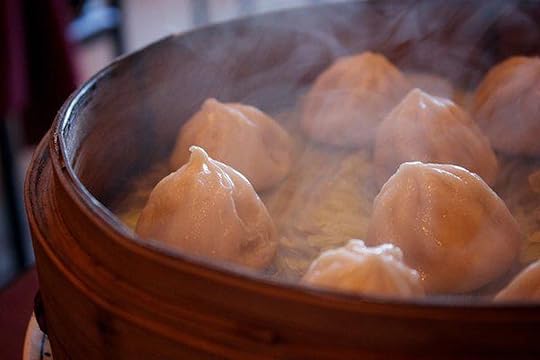
Photo: Lao Wang Noodle House/Facebook
As a fan of Vietnamese food, Nguyen suggested Pho Lee. “Federal Boulevard is where you’ll find all the best, authentic places in town, and I think the team at Pho Le does a really great job with their dishes, in particular capturing the nuances of regional Vietnamese culture and cuisine,” Nguyen said. “I especially like the bun bo hue — you have to try it!”
The stretch has more than just quality Vietnamese food.
“Everyone knows that S. Federal houses the most authentic, incredible hidden-gem Asian restaurants (Thai, Chinese, Vietnamese, Taiwanese) and hands-down my favorite is Lao Wang,” Vero said. “It’s an amazing mom-and-pop spot with the best, most authentic pot stickers and soup dumplings in the city. After a long day in the kitchen or on a rare free evening, you can count on finding [Hearth and Dram chef de cuisine Jeff Hickman and I] there. I also love Yabby Hut, a Viet-Cajun — yes, there is such a thing — style shellfish boil spot.”
On your next visit, these are the chefs to keep an eye out for.
“The chef in Denver that we should expect lots of great things coming this year is chef Anna Walter at Super Mega Bien,” Tran said. “She has a very unique and modern cooking style of Latino and Asian cuisine that is mind-blowing. She’s dedicated herself to her style of food and staying true to her flavors. Her roasted duck pekin — China/Latin America with chipotle-honey glaze served with housemade flour gorditas — is just amazing.”
Tran himself is someone to watch as well. “His food is stunning,” Vesta sais. “Amazing flavors and presentation, and his impact of the menu at Ace has brought back the food culture of Vietnamese-inspired cuisine to the Uptown Neighborhood of Denver, CO.”
Annette’s Caroline Glover is making an impression by staying independent, Holmes said, adding, “She’s fighting the good fight by being independent and I think we’ll continue to see her at the top of the lists.”
Along with his chef de cuisine Jeff Hickman, Vero has his eyes on Bo Porytko at Rebel Restaurant, Geoff Cox at Hop Alley, and Korey Sims at Aurum in Breckenridge. Taylor suggested frequenting Julep for Kyle Foster and Señor Bear for Blake Edmunds. Ceballos suggested watching Dana Rodriguez from Super Mega Bien and Work & Class, along with Efren Velazques of El Cazo and Tony Zarlenga of Cafe Brazil. 

More like this: The best places to eat in Denver right now
The post What to eat in Denver, according to Denver’s best chefs appeared first on Matador Network.

Krispy Kreme family has Nazi past

When you think of people with a Nazi past, soft, fluffy doughnuts don’t exactly spring to mind. Unfortunately, Germany’s second-richest family, which owns popular brands like Krispy Kreme doughnuts and Panera Bread, have admitted that their ancestors were strong Nazi supporters who used forced laborers during World War II. The Reimann family discovered these secrets about their ancestors after commissioning a historian to learn more about their suspected past.
It appears that Albert Reimann Sr. and Albert Reimann Jr., who ran the company in the 1930s and 1940s, were anti-Semites, fervent Hitler supporters, and used prisoners of war as forced laborers in their factories, as well as in their personal home. The treatment of the slave workers was reportedly extremely abusive. Reimann Sr. had even donated to the SS, and according to The New York Times, in 1937, Albert Reimann Jr. wrote a letter to Himmler, the leader the SS, saying, “We are a purely Aryan family business that is over 100 years old,” he wrote. “The owners are unconditional followers of the race theory.”
Upon learning of its troubled past, the Reimann family has expressed its shame and pledged to donate about $11.3 million to an as-yet-to-be-disclosed charity. They certainly aren’t trying to hide the revelations. Peter Harf, the Reimann family spokesperson and one of two managing partners of JAB Holding Company, which the family controls, said in an interview, “Reimann Sr. and Reimann Jr. were guilty. They belonged in jail.” 
H/T: Slate

More like this: The 11 best types of doughnuts served around the world
The post German family that owns Krispy Kreme to donate millions after discovering dark Nazi past appeared first on Matador Network.

March 25, 2019
Iceland's fermented shark festival

I smelled them before I saw them. Two boys, both around four years old, roaming around a music store in downtown Reykjavik with an aroma of ammonia, fish, and rottenness trailing behind them. An employee bent down to speak to one of the boys and asked in Icelandic if he had eaten hakarl, or fermented shark. An enthusiastic “Ja!”’ was the reply. “Vel gert!” She smiled and gave him a high five. The other child wore a handmade crown, the kind you make in kindergarten with construction paper, glitter, and feathers. In this case, the crown had pictures of traditional foods like sheep head that are eaten during the þorrablót festival. It was Bóndadagur, the kick-off day to þorrablót season in Iceland.
Þorrablót (or Thorrablot) is an Icelandic pagan festival that was suppressed with the spread of Christianity around 1000 AD. In 1904, Iceland gained full independence from Denmark, and a rising nationalism movement brought Icelandic traditions to the forefront, including Þorrablót in the previous decades. The festival begins on the first Friday following January 19, known as the 13th week of winter in the country, and likely gets its name from Thor, the Nordic god of thunder, or the mythological king Thorri Snæsson. A big part of reviving Iceland’s festival was and is centered around traditional foods, and it’s the best time of year to try some of the dishes from Iceland’s past.
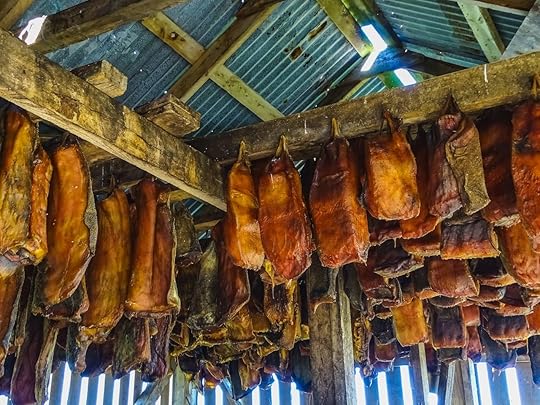
Photo: IAM photography/Shutterstock
A short list of what you can expect to see: fermented shark, boiled sheep head, liver sausage, sour ram testicles, smoked lamb, dry fish, and plenty of local beer and liquor. These dishes can be traced back to the revival of the festival in the 1950s.
It can be a bit much for people unfamiliar with the ingredients, but you won’t be alone if you opt out of tasting. I asked several Icelandic friends if they would be participating in þorrablót this year, and the general consensus was, “No, it’s disgusting,” and “I don’t eat þorrafilth.” Even the late Anthony Bourdain, who tried nearly every so-called delicacy around the world, bemoaned fermented shark as “the single worst, most disgusting and terrible tasting thing” he’d ever eaten. Beyond its acquired taste, though, the food itself tells a broader story about the country.
Celebrating the right way

Photo: Jon Naustdalslid/Shutterstock
Whether you attend a traditional party or experience the cuisine at a local restaurant, there’s often an undertone of black humor to the promotion of the tradition. Advice on sampling the dishes tend to fall somewhere along the lines of “Don’t worry if you can’t hold back your gag reflex,” and “Just try not to focus too much on what you’re eating.”
Joking aside, Þorrablót is a way to preserve and claim ownership of community values and celebrate the history of Iceland. The foods are symbolic, and some locals are working to put more focus on the tradition itself instead of letting it turn into little more than a tourist attraction. Jón Ferdínand Estherarson, a political science and history student at the University of Iceland, tells me the ingredients were eaten out of necessity from the 1500s to the 1800s, and the circumstances surrounding the food culture are missing from many modern parties.
“The romantic nationalists of the Independence Era wanted to find national icons and symbols, shared commonalities to ‘unite’ us, but they had little benefit in representing the real misery and desperation behind the curtain,” he says. “It’s far from glamorous. It’d be fine if they were upfront about that, if there was a sense of meaning and shared sadness with our ancestors. A sense of respect for their sacrifices and hardship. But instead, it’s a debaucherous drunk fest. A functional þorrablót might be to dampen and temper our exaggerated sense of grandiose self as a nation. To imbue a sense of humility and gratitude into our collective psyche.”
Midwinter was an especially tough time for food. People were generally drawing on the last of their reserves that got them through the cold months, hence all the fermented foods. Today, it’s important to remember why these foods were chosen to represent the country.
Modern Þorrablót traditions
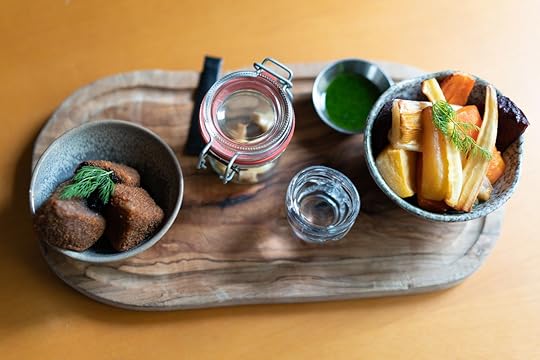
Photo: Eliyahu Ungar-Sargon/Shutterstock
Traditions by their very nature are a way of reinterpreting history, and Þorrablót is no exception. It’s dynamic and evolves as generations adapt new perspectives — evidenced by my friends’ lack of interest in the foods on offer. In Iceland today, the tradition of þorrablót has two audiences. The first is the Icelandic community, where the festival serves to reinforce nationalistic pride and celebrate the country’s Viking past. The second is tourists intrigued by the food culture of Iceland. The latter should always follow the lead of people celebrating their heritage.
There are a couple of ways to try þorrablót meals. Both tourists and locals alike can purchase buckets of sour animal parts in Icelandic supermarkets and do the preparations themselves. You can also purchase a plate of þorramatur foods at tourist-friendly restaurants like Cafe Loki. Parties with buffet-style feasts are held in downtown Reykjavik and the countryside, but tourists should plan ahead if they want to score invitations or tickets to them.
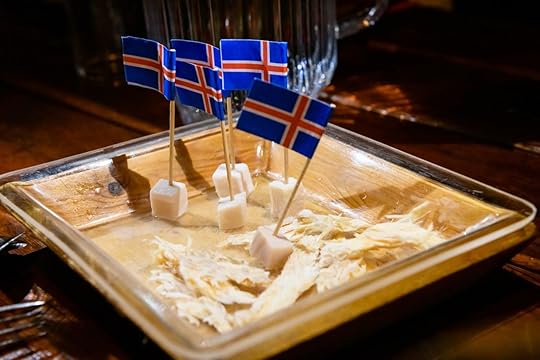
Photo: Teo Wei Keong/Shutterstock
The continued preservation of these fermented foods and the consumption of them every year has little to do with the taste and more the symbolism and its deeper importance in Icelandic culture. Without respect to the past, the experience is susceptible to becoming neither historically accurate nor emotionally authentic, and at worst exploitative by tourists. But when celebrated properly, these traditional dishes can be an opportunity for reflection on Iceland’s storied history — whether you’re able to keep it down without grimacing or not. 

More like this: Why you need to go to the Westman Islands in Iceland
The post Understanding Þorrablót, Iceland’s fermented-shark-meat-filled festival appeared first on Matador Network.

Most scenic airport named

Private jet booking platform PrivateFly just released its list of “most scenic airports for landings,” and unsurprisingly to anyone who has ever flown over the verdant Land of Éire, Donegal Airport in Ireland tops the list.
To compile the list, PrivateFly gathered responses from 7,000 participants who nominated airports they believed to be the most scenic. According to Adam Twidell, CEO of PrivateFly, the poll is meant to encourage travelers to not just focus on disembarking and rushing through the airport, but to “stop, take a look through their aircraft window and be awestruck by the joy of flying.” The poll ranked 129 airports around the world, and for the second year in a row, Donegal Airport in north-west Ireland secured the number one spot, thanks to its dramatic surroundings of mountains and beaches.
Of Donegal’s picturesque backdrop, one voter said, “The view is spectacular. Mountains on one side and a beautiful rugged coastline dotted with islands and golden sandy beaches running adjacent to the runway.” Another voter said it was the “most beautiful scenery I ever saw, with the beach on one side with crystal clear water, and Mount Errigal standing tall on the other side.”
The other airports recognized for the aesthetic brilliance are as follows:
2. Barra Airport (Scotland)
3. Nice Airport (France)
4. Orlando Melbourne International Airport (USA)
5. St Maarten (Netherlands Antilles)
6. Saba Airport (Netherlands Antilles)
7. Queenstown Airport (New Zealand)
8. Billy Bishop Toronto City Airport (Canada)
9. London City Airport (England)
10. Aosta Airport (Italy)
People might not start choosing their destinations based on airport landing strips anytime soon, but at least these picturesque airports are getting the recognition they deserve. 
H/T: Lonely Planet

More like this: The 10 best airports in Europe to travel through
The post Ireland’s Donegal Airport named the world’s most scenic airport for landings and take-offs appeared first on Matador Network.

Best places for punting in England

Conjuring up images of lazy summer days on the river, straw boaters, and picnics, punting is on par with Wimbledon and cream teas as a quintessentially English pastime. Not only a unique way to experience a destination, punting is simply just a lot of fun.
Traditionally used to transport cargo, boat punting became a popular leisure activity between 1860 and 1880 on the River Thames in London. These days, punting is primarily associated with the university cities of Cambridge and Oxford, where students earn beer money by “chauffeuring” tourists along the river to take in the sights. However, Cambridge and Oxford aren’t the only places in England where it’s possible to put your punting skills to the test.
In all of the following destinations, you can either hire a chauffeur or give punting a go yourself. The boats are square-ended with a flat bottom and are suited to shallow waters. They are propelled along by pushing the 16-foot-long pole against the river bed. Simply drop the punt into the water, draw it out, and do it again. Of course, it’s not quite as easy as it sounds, but with a little practice, it doesn’t take long to get the hang of it.
1. Cambridge

Photo: Pajor Pawel/Shutterstock
Cambridge is probably the first place that many people think of when it comes to the activity of punting. The River Cam runs through the city and passes what are known as the “Backs,” which refers to a one-mile stretch where the rear sides of some of the most prestigious and oldest universities in the country can be seen.
Chauffeurs are usually Cambridge University students who can be relied upon to amuse their passengers with entertaining tales about the outlandish antics of former alumni. A few of the famous colleges that can be seen from the river include Trinity College, which was founded by King Henry VIII in 1546; Trinity Hall, where scientist Stephen Hawking studied; and St. Johns College, which was attended by poet William Wordsworth.
The Backs can become congested in the summer months, but Grantchester, a couple of miles south of the city, offers a more tranquil alternative. Boats float past open meadows and woodlands, the branches of weeping willows sway over the river, and birds sing in the background. Idyllic.
2. Oxford

Photo: hbpro/Shutterstock
The River Cherwell is a tributary of the Thames and flows through the city of Oxford. Like Cambridge, the river passes many of Oxford University’s great colleges, including St. Hilda’s College, where Prime Minister Theresa May studied, and Magdalen College, where Oscar Wilde was a scholar. The Oxford Botanical Gardens can be seen from the river, and there are plenty of excellent picnic spots. Parson’s Pleasure was formerly a nudist bathing spot for Oxford Dons, or professors, and is now part of the university park.
The more adventurous may wish to head for Folly Bridge, south of the city. Here it’s possible to punt along the Thames, a wider stretch of water but nevertheless shallow on the sides. One of the most scenic spots is to the west of Oxford, on the Isis next to Port Meadow, where the scenery is pretty as a picture, and you can drop into a variety of tempting country pubs.
3. East London

Photo: mikecphoto/Shutterstock
For a completely different waterway excursion, you can punt along Regents Canal in East London. Boats are available to rent between Mile End Lock and Old Ford Lock, where the sights and sounds encountered are less English countryside and more urban grit. The path next to the river is full of activity with runners, walkers, and cyclists who have escaped the busy city streets and are making the most of the relative tranquillity of the riverside.
Graffiti replaces grass and trees, but one advantage of punting on Regent’s Canal is that there are plenty of pubs with gardens where you can take a break and enjoy a pint and some hearty pub grub. A punting trip can also be combined with a visit to the fascinating cultural melting pot of Brick Lane or Jack the Ripper’s stomping ground of Spitalfields, both located nearby.
4. Canterbury
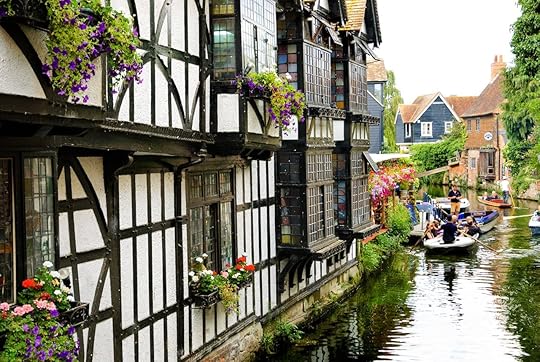
Photo: Elena Dijour/Shutterstock
The Great Stour River runs through the heart of Canterbury’s historic city center and offers an abundance of medieval architecture, secret gardens, priories, and churches to observe as you float along. From the Blackfriars Dominican Priory, which dates back to 1237, to Greyfriars Chapel, the oldest Franciscan building in Europe, viewing the city from the river is like being transported back to another era.
A chilled out countryside jaunt provides an opportunity to take in some beautiful rural Kentish scenery and perhaps even spot some wildlife. For some spine-chilling thrills, it’s possible to take a punted ghost tour at night when passengers are given an insight into the city’s spooky side.
5. Stratford-upon-Avon
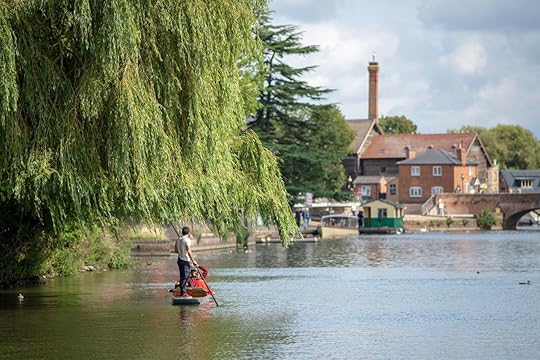
Photo: Paul Rushton/Shutterstock
The River Avon is a picturesque waterway which is perfect for punting. Swans and ducks paddle alongside the boats, and the rural countryside is the perfect backdrop for a leisurely trip down the river. There is plenty to look at, too. The Royal Shakespeare Theatre sits on the riverbank, as does Holy Trinity Church where William Shakespeare was both baptized and buried.
The lawns of Bancroft Gardens, adjacent to the theater, are where townspeople grazed their cattle back in the day. Punting along the Avon also allows river-trippers to have a peek at some stunning riverside properties and their gardens — an ideal way to enjoy a taste of Shakespeare’s home county of Warwickshire. 

More like this: Skip the Cotswolds — Blackmore Vale is the storybook England of your dreams
The post The 5 most beautiful places to go punting — the quintessential English pastime appeared first on Matador Network.

Best European music festivals

Not that you ever need an excuse to head to Europe during the summer other than it being Europe in the summer. But sometimes it’s nice to have an event to base your travels around and something to do other than fight the million other Americans who also thought this would be a good time to cross the pond. European music festivals offer the perfect centerpiece to a summer Eurotrip, a weekend where you can converse with people from all over the world and maybe catch Cardi B somewhere along the way. As summer creeps in and you start planning what to do once the weather gets warm, here are a dozen festivals you can plan your trip around.
1. Primavera Sound — May 30 – June 1 (Barcelona) and June 6-8 (Porto)
Barcelona, Spain, and Porto, Portugal

Photo: Primavera Sound/Facebook
Most two-weekend festivals limit themselves to one locale to simplify logistics. Not Primavera Sound, which gives you the chance to hit two of the Iberian Peninsula’s most popular summer destinations by going both weekends. The festival lineup gives us a little bit of everything, with Barcelona headliners including Cardi B, Tame Impala, and Solange, and Porto featuring J Balvin, Interpol, and Erykah Badu. Both festivals are held right near the water too, offering two of the prettiest festival settings on the continent.
2. Earth Garden — May 30 – June 19
Ta’Qali National Park, Malta
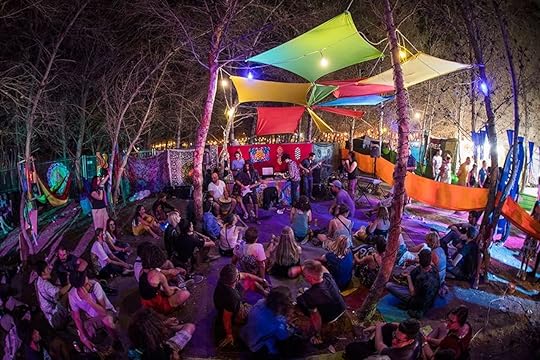
Photo: Earth Garden/Facebook
Though its recent tourism explosion sometimes leaves the island of Malta feeling oversaturated, an escape into the forest at Earth Garden allows you to appreciate the nature that brought so many people here in the first place. The three-day festival will have you camping in the middle of a national park, bouncing between healing sessions and concerts in an “Enchanted Forest.” The acts here might offer the best variety of any festival on the summer Euro circuit, with over 100 performers ranging from ska to funk to hip-hop. You won’t find huge-name headliners, but if you’re more into the experience than Insta-braggable names, this is the festival for you.
3. Sweden Rock Festival — June 5-8
Solvesborg, Sweden

Photo: Sweden Rock Festival/Facebook
While European festivals tend to be long on electronic music and whatever’s killing the Top 40, the Sweden Rock Festival dates back to the early ‘90s and is a welcome change for those who love good old rock and roll. Europe’s largest rock fest is four days of classic rock, metal, and blues, and this year it’s headlined by KISS, ZZ Top, and Slayer. You’ll find the grounds meticulously maintained over the festival’s four days, as well as indoor flushing toilets and concession lines that move efficiently. Perfect, maybe, for the aging rock and roller who’s not so into chaos anymore.
4. Donauinselfest — June 21-23
Vienna, Austria

Photo: Donauinselfest/Facebook
For the budget Euro traveler, no festival tops Donauinselfest, the biggest and best free music festival in Europe. It draws over two million people over the weekend, making it the largest free outdoor festival in the world. The whole thing goes down on Donauinsel Island in the middle of the Danube River, where 10 stages and 18 tents offer over 600 hours of shows. This year’s lineup won’t be announced until mid-May, but last year Michael Bolton joined an extensive lineup of German and Austrian acts.
5. Glastonbury — June 26-30
Worthy Farm, England

Photo: Glastonbury Festival/Facebook
Though it might not have invented the field festival, Glastonbury has certainly perfected it over its nearly 50 years, drawing over 175,000 people for art, music, and pretty much anything else you can put on a stage. The UK’s largest music fest took last year off and returns with The Killers, The Cure, Janet Jackson, and Tame Impala leading the continent’s most impressive summer lineup. It’s still a camping festival — so while the music is first-rate, don’t go expecting a luxury experience. Still, Glastonbury’s a chance to get outside for a few days in the English countryside and enjoy its brief stint of nice weather.
6. Roskilde — June 29 – July 7
Roskilde, Denmark

Photo: Roskilde Festival/Facebook
Though a lot of festivals talk a big game about togetherness, community, saving the planet, and all that other happy stuff, Roskilde puts its money where its marketing mouth is. The festival is a non-profit organization in which workers are all volunteers, and 90 percent of the food served is organic. It’s also one of the oldest festivals in Europe, dating back to 1971, with genres all over the board. This year’s edition brings Bob Dylan to the stage along with Cardi B and Robert Plant. Hopefully all at the same time.
7. Balaton Sound — July 3-7
Lake Balaton, Hungary

Photo: Balaton Sound Official/Facebook
The people behind the massively popular Sziget festival founded this offshoot in 2007, an EDM-heavy fest held right on the shores of Lake Balaton. Balaton Sound is as close as you’re getting to a large-scale beach festival in Europe where campers set up on the sand and take the short walk over to the stages. This year the lineup delves a little further into hip-hop acts than in previous editions, where Future, Denzel Curry, and Yxng Bane join the likes of Armin Van Buuren and Tiesto.
8. Exit — July 4-7
Novi Sad, Serbia

Photo: Exit Festival/Facebook
When the Austrian Empire built the Petrovaradin Fortress during the 17th and 18th centuries, they probably never thought it would be filled with people listening to a guy named DJ Snake. But such is the world we live in today, where this historic fort hosts the annual Exit Festival, a largely EDM extravaganza held in one of the world’s most unique venues. The festival actually started as a student movement during the 1990s, fighting for peace and democracy after the fall of the iron curtain. But now it’s an excuse to sit out in the sunshine and enjoy music from Europe’s top DJs, with a handful of bands thrown in as well.
9. Ultra Europe — July 12-14
Split, Croatia

Photo: Ultra Europe/Facebook
The world’s biggest electronic music festival has now spread to nearly every continent — with the European edition, Ultra Europe, going down at Poljud Stadium in the seaside paradise of Split. The main festival is pretty self-contained within the stadium walls, where previous headliners have included Armin Van Buuren, Hardwell, and Axwell & Ingrosso. But perhaps the best part of the festival experience is outside Ultra itself, where you’ll find countless boat parties, beach parties, and other associated events that make this the best weekend of the year in Split.
10. Tomorrowland — July 19-28
Boom, Belgium

Photo: Tomorrowland/Facebook
Arguably the most famous European summer music festival, Tomorrowland draws tens of thousands of people over two weekends to the appropriately named town of Boom. The EDM-heavy fest is an onslaught of oversized art pieces and hard-pounding electro, with names like Carl Cox, Eric Prydz, Afrojack, and The Chainsmokers heading this year’s bill. Adjacent to the festival you’ll find Dreamville, the sprawling campground that offers everything from basic tents to full-on pop-up cabins, which turns into a secondary party of its own after the music’s over.
11. Sziget — August 7-13
Budapest, Hungary

Photo: Sziget Festival Official/Facebook
Sziget translated into English means “island,” a perfect descriptor of this mid-August tradition that separates you from the rest of the world both physically and mentally. Sure, Óbudai-sziget, or Old Buda Island, is just north of Budapest in the middle of the Danube River. But once you cross the bridge into the festival you’ll feel a world away, where over 1,000 performances, art exhibits, and performance pieces give it the feel of another dimension. Going for a full week can be intense, so you might be best advised to camp out for two or three days, based around the headliners you want to see. This year’s include Post Malone, Foo Fighters, and Ed Sheeran.
12. Iceland Airwaves — November 6-9
Reykjavik, Iceland
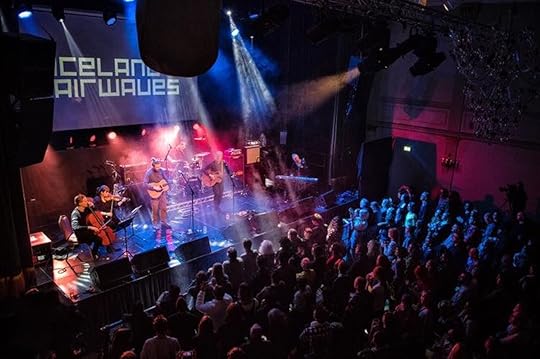
Photo: Iceland Airwaves/Facebook
Ok, so Iceland Airwaves doesn’t take place anywhere near the summer, but did you really want to go to Iceland when it was filled with busloads of midnight-sun-chasing tourists anyway? Of course not! Better to go when the city is overrun with people looking for hot new music that wasn’t on the summer’s festival circuit. Iceland Airwaves has become a little like the music equivalent of the Sundance Film Festival, where heretofore-unknown acts go to be discovered and distributed. Bands like Monsters of Men, Kaleo, and Florence and the Machine played here long before they were household names. Even if you don’t see the next big thing, you’ll still see plenty of Icelandic bands that may open your mind to a whole new genre. 

More like this: 16 awesome Canadian festivals you should check out this summer
The post 12 European music festivals you need to hit this summer appeared first on Matador Network.

Types of moonshine around the world

Illegal liquor is a lot like a good hole in the wall restaurant. No matter where you’re at, you can find it if you know the right people to ask.
Moonshine, as it’s known in the US, has a storied history as the liquid that changed the hills of Appalachia, built fortunes for Prohibition-era mobsters like Al Capone, and made a star out of Popcorn Sutton. It’s far from a stateside phenomenon, though. The tradition of fermenting and distilling whatever grain, sugar, or fruit is cheaply available has been happening around the world for basically as long as people have had the know how to do so.
The appeal for moonshine makers and drinkers is primarily price. Since it’s untaxed, it can be just a fraction of the cost of a bottle of alcohol purchased at a liquor store. However, also since it’s untaxed, it’s unregulated and can be improperly made or even laced with poisons. Still, it’s easy enough to find on your travels depending on where you go.
Unregulated liquor is about as much bound by borders as it is bound by the law. Which is to say, not at all. Many countries in the Balkans use some form of the word raki to describe their moonshine while a number of countries in Southeast Asia use the word arrack. Regardless of name, each region has its own slight variation on moonshining. From Ireland to Haiti and everywhere in between, these are the most famous moonshines made around the world you need to try — if you think you’re up for the challenge.
1. The Balkans: rakia (also spelled raki and rakija)
Like Italian grappa, raki is made with the solid fermenting skins, seeds, and stems of grapes after they’re pressed to make wine. Often it’s made with other fruits available in the area, like plums, pears, apples, and peaches. Sometimes it’s a mix of all of the above, but you’ll rarely know unless you ask. The taste varies by who makes it, but it loses the vast majority of the taste of the fruit its made from in the distillation process. The one rakia taste you’ll always pick up is a strong alcohol burn although spices or honey is sometimes used to cover that up. It’s served in small shot glasses and consumed in one go, often with food and always with other people.
Some of the places you can find raki are Albania, Bosnia and Herzegovina, Croatia, and Bulgaria. Sellers peddle their spirits on the street, encouraging the homemade status of their bottles of (mostly) clear liquor. It’s also found on store shelves with handwritten labels, but locals stick to the stuff they make at home or get from their neighbor.
2. Turkey: raki

Photo: Nadir Keklik/Shutterstock
Yes, it has the same name as the raki above, but Turkish raki deserves a special mention. It’s more consistent than in the Balkans in that it’s always flavored with anise, giving it a similar taste to ouzo from Greece or pastis and absinthe from France. It’s earned a reputation as Turkey’s national drink and also goes by the name Lion’s Milk thanks to the opaque white color the spirit turns when a bit of water is added.
In Mexico, there’s a saying that goes por todo mal, mezcal, y por todo bien, tambien, which loosely translates to “for everything bad, there’s mezcal, and for everything good, there’s also mezcal.” The same goes for raki in Turkey. It opens up conversations when someone is feeling down and leads to dancing on tables during celebrations.
Raki is most often drunk in a chilled glass and is diluted with cold water. It has a strong anise flavor, and it’s always enjoyed with company during drinking sessions that can go all night. Letting all those drinks get to you is frowned upon, though, despite its strength. Thankfully, you’ll always find small plates of food on the table alongside the alcohol. Be sure to clink the bottom of your glass when you cheers — clinking the top means you think you’re better than the other person.
3. Haiti: clairin
Clairin is the traditional name for Haiti’s local rum-like spirit. It’s made from fresh sugar cane juice, unlike rum, which is most often made from molasses. The exact process and types of stills used vary from community to community, but it’s funkier than rum and has a sweet vegetal note to it. Each distiller uses whatever variety of sugar cane is nearby, and wild yeast ferments the pressed juice.
According to a company called Clairin that recently started exporting the drink to the US, there are more than 500 community-run stills in Haiti making local versions of clairin (exact numbers are hard to come by since it’s not government regulated). No single distiller makes enough to have any sort of dominance in the local clairin market, but it’s easy enough to find the hyperlocal spirit in clear plastic bottles. Thanks to the community-maker aspect, clairin has a real sense of place connected to the part of the island it’s made in.
4. Ireland: poitin
Pronounced puh-cheen, this Irish moonshine is the country’s true regional spirit. It’s made from whatever is available, which, depending on the area, can mean potatoes, barley, or sugar beets. The taste is influenced by whatever it’s made from but is often a touch sweet. The name comes from the traditional word for “small pot” in reference to the home-sized stills that true poitin is made in. Home distillation was pushed underground when it was outlawed by King Charles II in 1661 to keep distillers from tax evasion, and the all-out ban on the spirit category wasn’t corrected until 1997.
Irish whiskey stole the spotlight for much of the country’s long and illustrious distilling history, but clear, unaged poitin is starting to make a comeback thanks to a few moonshine-gone-legit companies selling bottles in the states, like Mad March Hare, Straw Boys Poitin, and Glendalough.
5. Georgia: chacha

Photo: Chubykin Arkady/Shutterstock
The country of Georgia may be known for being one of the oldest wine regions in the world, but the drink of the people is chacha. The fiery spirit is similar to raki and Italian grappa in that it’s made with the grape pomace leftover from winemaking, and it’s often high in alcohol and unrefined.
You don’t need to visit any type of speakeasy to get a taste of chacha; all you need to do is step into the country. It’s given to visitors by locals eager to share their traditions and culture, and it’s served at pretty much every bar and restaurant, where small shots poured from unmarked bottles are passed around. More often than not these bottles come from a local distiller rather than any government-regulated industry. A toastmaster leads the drinking during meals, and it’s considered rude to not partake — regardless of how many toasts the leader wants to make.
6. India and Southeast Asia: arrack
Arrack was once a catch-all term for spirits from Southeast Asia, but the word has been refined down to referring primarily to a distilled beverage made from coconut palm sap or sugar. By some accounts, it’s the oldest spirit in the world, and it was the base spirit for punches and cocktails when sailors passed through modern-day India, Sri Lanka, and Indonesia (where it’s often spelled arak) during the Age of Exploration. Colonization and subsequent taxation pushed arrack to the fringes of the black market, and it further solidified its position as a homemade spirit after World War II.
It’s impossible to ignore how big of an impact arrack had on the way people drink liquor today. It was more than likely the ingredient used in the first punches and cocktails before it was replaced by the more readily available rum. Unregulated arrack is cheap and easy to find, but it’s often cut with poisons, and it’s a gamble if you don’t know your source. 

More like this: The one drink you need to know before visiting the country of Georgia
The post 6 white-hot moonshines from around the world worth trying appeared first on Matador Network.

King Tutankhamun exhibit in Paris

After the discovery of the tomb of King Tutankhamun in 1922, the subsequent story of the King Tut’s curse turned the 1967 exhibition in the Petit Palais in Paris into one of the biggest archaeological sensations of the 20th century, drawing 1.2 million visitors and sparking public interest in Egyptian archaeology. This year, the treasures of Tutankhamun are on display in Paris once again, in a rare exhibition at the Grande Halle de la Villette. The “Treasures of the Golden Pharaoh” which opened in Los Angeles in March 2018, is now in Paris until September, under the name “Tutankhamun, Pharaoh’s Treasures.” It’s the exhibition’s only stop in continental Europe.
More than 150 objects from Tutankhamun’s tomb are set to be displayed — many of which have never before left Egypt. The treasures include an assortment of jewelry that were found on the Pharaoh’s body, his gold funeral mask, gold-plated wooden bed, and many other artifacts, including the statue of Amun protecting Tutankhamum, lent by the Louvre for this historic exhibit. The exhibition’s website invites visitors to “come discover many personal belongings of the young sovereign [that] accompanied him in the two worlds that are life and death.”

Photo: Expo Toutankhamon Paris/Facebook

Photo: Expo Toutankhamon Paris/Facebook
The event is being highly publicized all over Paris, and over 150,000 tickets were sold on March 22, one day before the opening of the event.
The exhibition will travel to another eight countries around the world, ending in 2022, one hundred years after the tomb’s discovery, when it will be on permanent display at the Egyptian Grand Museum that is currently under construction. The Paris show will run through September 15, and tickets are between $25 and $30. 
H/T: France 24

More like this: 7 underrated sites in Egypt worth visiting, according to an archaeologist
The post Dive deep into King Tutankhamun’s treasures at this huge Paris exhibit appeared first on Matador Network.

Flight accidentally lands country

A plane touching down on a runway is one of the best feelings for a traveler, but touching down at the wrong airport might be one of the worst. On Monday, a British Airways flight departed from London City Airport and landed safely in Edinburgh. The only problem was that the destination was supposed to be Düsseldorf, Germany. The 500-mile mistake in the flight plan supposedly occurred due to incorrectly submitted paperwork. Passengers only realized the mistake when the plane announcement said, “Welcome to Edinburgh.”
According to Sophie Cooke, a 24-year-old management consultant who flies the route often, the crew only realized the mistake when she asked a flight attendant if they were joking. She told the BBC that, “The pilot said he had no idea how it had happened. He said it had never happened before and that the crew was trying to work out what we could do.”
The plane did eventually bring the passengers to Düsseldorf, but not before it sat on the Edinburgh tarmac for two and a half hours with a blocked toilet and no snacks.
According to The Guardian, passengers will receive financial compensation of about $280. A British Airways spokesperson said that they were further investigating the cause of the incident and apologized for the mistake. 
H/T: BBC News

More like this: The world’s safest airlines of 2019
The post Flight to Düsseldorf accidentally lands in Edinburgh, 500 miles in the wrong direction appeared first on Matador Network.

Matador Network's Blog
- Matador Network's profile
- 6 followers



